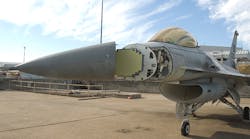The Scalable Agile Beam Radar – Global Strike (SABR-GS) is a full-performance, multi-function, active-electronically-scanned-array (AESA) radar. It also has been tapped to replace the APQ-164 radar currently deployed on all U.S. Air Force B-1 bombers. Developed by Northrop Grumman, the SABR-GS offers a variety of enhanced operational capabilities and reliability compared to the legacy passive ESA. The new radar was recently unveiled at the anniversary of the B-1B Lancer.
Unlike traditional mechanically scanned radars, SABR’s electronic scanning eliminates the need for moving parts. (See "F-16 Electronic Scanning Radar Enhances Target Detection, Tracking".) SABR-GS features large synthetic aperture radar maps, advanced image processing, and sensor integration for more robust intelligence, surveillance, reconnaissance, and targeting. It also uses open architecture standards to integrate data from other onboard sensors, a feature that extends the life of the system.
SABR-GS incorporates the hardware and operating and software modes from Northrop Grumman’s F-35 and F-22 AESA radars, with about 85% of the suite coming directly from the AN/APG-81 radar. Its image and video processing algorithms will automatically scan entire SAR maps to locate and classify targets of intent, helping to reduce workload. The new radar is approximately three times the size of the former system, offering enhanced target area detail and larger digital maps under all weather conditions.
The SABR-GS’ development occurred under a $21-million risk reduction contract awarded by the Air Force’s B-1 Systems Program Office. The contract will be completed following the success of the Radar Modernization Improvement Program (RMIP). Northrop Grumman will continue to modernize the radar receivers and processors of the B-1.
